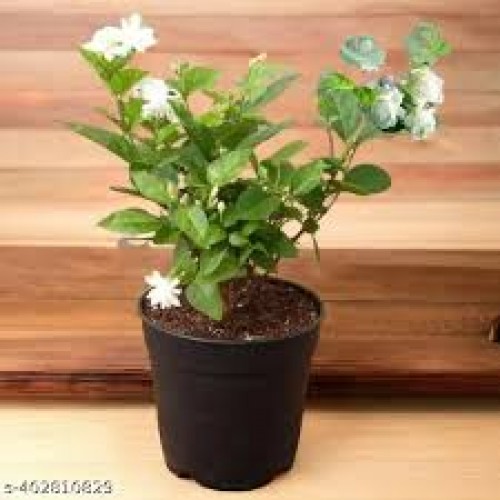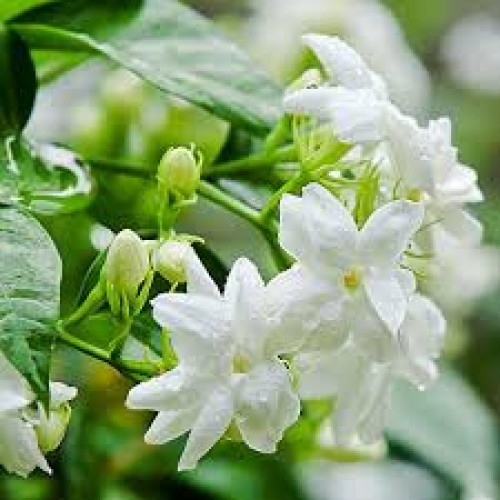off
-
Sold
-

-

out
Mogra Plant: Nature, Care & Advantages
The **Mogra plant** (Jasminum sambac), also known as **Arabian Jasmine** or **Spanish Jasmine**, is a beautiful, fragrant flowering plant native to Southeast Asia. Renowned for its sweet-smelling white flowers, Mogra is often grown for its ornamental value, aromatic appeal, and medicinal properties. Its rich fragrance and delicate white blooms make it a favorite in gardens, home decor, and even religious offerings.
Nature of the Mogra Plant
The Mogra plant is a small, evergreen shrub that produces fragrant white or off-white flowers, which bloom predominantly in the warmer months. It belongs to the **Oleaceae** family, which also includes olives and lilacs. Mogra plants have glossy, dark green leaves and can grow to a height of 3-6 feet (90-180 cm), making them suitable for both small gardens and large landscapes. They are known for their strong fragrance, which attracts pollinators like bees and butterflies.
This plant is highly valued for its ornamental and aromatic qualities. The flowers are commonly used in garlands, perfumes, and essential oils. Mogra is often found in tropical and subtropical regions, thriving in areas with warm climates and well-drained soil.
Care for the Mogra Plant
- Climate: Mogra thrives in tropical and subtropical climates with warm temperatures. It prefers temperatures between 25°C to 35°C (77°F to 95°F). It requires full sunlight for at least 4-6 hours per day to promote healthy growth and abundant blooming.
- Soil: Mogra plants prefer well-drained, fertile soil. A loamy or sandy soil that retains moisture without becoming waterlogged is ideal. Ensure the soil has a slightly acidic to neutral pH for optimal growth.
- Watering: Water the Mogra plant regularly, but avoid over-watering. The plant likes moist soil, but excessive moisture can lead to root rot. Water deeply, allowing the water to reach the roots. During the growing season, ensure the soil remains consistently moist.
- Fertilizing: Apply a balanced, slow-release fertilizer during the growing season (spring and summer). Organic compost or a liquid fertilizer high in phosphorus will encourage blooming. Reduce fertilization during the dormant months (fall and winter).
- Pruning: Regular pruning helps maintain the shape and size of the Mogra plant. Trim the plant to remove dead or damaged branches, and cut back long or overgrown stems. Pruning after the blooming season encourages new growth and more flowers.
- Support: Mogra is a vine-like plant that benefits from some support, such as a trellis or fence. As it grows, it can become sprawling, so providing vertical support helps the plant grow upward and remain healthy.
- Pests and Diseases: Mogra plants are generally resistant to pests, but they can sometimes attract aphids, spider mites, and mealybugs. Use organic insecticidal soap or neem oil to manage pest infestations. Ensure the plant is not over-watered, as excessive moisture can lead to fungal diseases.
Advantages of the Mogra Plant
- Fragrance: The most notable feature of the Mogra plant is its sweet, intense fragrance. Its flowers are commonly used in making perfumes, essential oils, and incense, adding a pleasant aroma to the home or garden.
- Ornamental Value: Mogra's white, star-shaped flowers add an aesthetic charm to any garden or indoor space. Its dense foliage and attractive flowers make it a popular choice for ornamental purposes, including landscaping and decoration.
- Medicinal Properties: In traditional medicine, Mogra flowers are known for their calming and soothing properties. The flowers are often used in herbal teas to relieve stress and anxiety, promote sleep, and help with respiratory conditions. The plant is also believed to have anti-inflammatory and antioxidant properties.
- Pollinator-Friendly: Mogra plants attract pollinators such as bees, butterflies, and birds. By planting Mogra in your garden, you can help support local biodiversity and contribute to the health of your ecosystem.
- Air Purification: Like many plants, Mogra can help purify the air by absorbing carbon dioxide and releasing oxygen. The addition of Mogra to your home or garden can enhance air quality and create a healthier environment.
- Cultural Significance: Mogra is highly revered in many cultures, especially in India, where it is often used in religious offerings and festivals. The flowers are associated with purity, beauty, and divine energy, making them a symbol of good fortune and blessings.
- Low Maintenance: The Mogra plant is relatively easy to care for once its basic needs are met. It is well-suited for beginner gardeners and can thrive with minimal maintenance, provided it gets the right amount of sunlight and water.
Conclusion
The **Mogra plant** is a versatile and fragrant addition to any garden or home. With its stunning white flowers and aromatic appeal, it brings beauty and freshness wherever it is grown. Whether you're using it for ornamental purposes, medicinal uses, or simply enjoying its fragrance, Mogra is a plant that offers both aesthetic and practical benefits. With proper care, it can thrive and flourish, becoming a valuable asset to your green space.